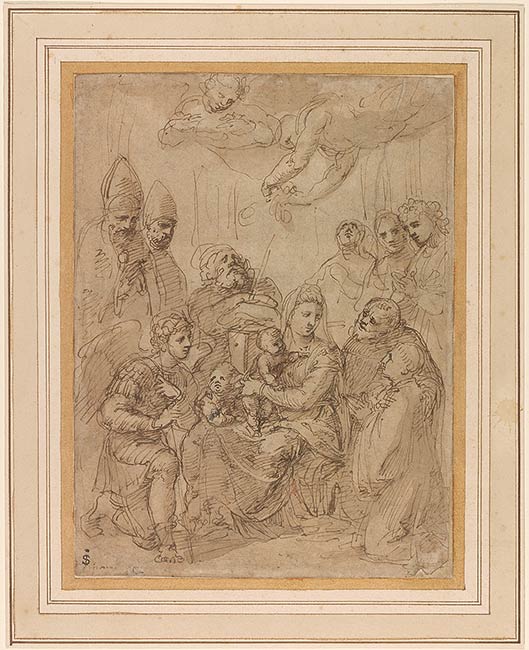
Like Leonardo, Michelangelo, Raphael, and Giulio Romano, Peruzzi was a typical Renaissance polymath, a painter as well as an architect and a designer of theatrical productions and decorative arts, a creator of both secular and sacred works of art. No details are known about Peruzzi’s training, but he was heavily influenced by Francesco di Giorgio Martini, who was similarly a painter, sculptor, architect, and designer. Peruzzi must have learned much of his craft under Francesco di Giorgio and his followers in Siena, to which his distinctively Sienese drawing style attests. His sketches compare to those by Sienese contemporaries such as Girolamo del Pacchia, Vincenzo Tamagni, or Sodoma, to whom this drawing was long attributed.1
By 1503 or 1504, however, Peruzzi was in Rome, probably having traveled there upon the election of the Sienese pope Pius III. His earliest works included frescoes at Sant’Onofrio, still in a traditional style akin to that of Pinturicchio, whose work Peruzzi would have seen in the Piccolomini Library of the Siena cathedral (see 1996.9). Once in Rome, however, Peruzzi’s close study of Roman antiquity and of modern artists, particularly Raphael, transformed his work. His reputation among his contemporaries seems to have been great, but so little survives—particularly of his painting— that he is today an enigmatic figure. It may also have been the case that Peruzzi, like Leonardo da Vinci, was an artist for whom the moment of invention in drawings was of more interest than the execution of finished works; many drawings by Peruzzi survive, both figural and architectural in nature, but relatively few of these correspond to works known to have been created.
The present compositional drawing is a typical example. Showing the Holy Family surrounded by St. Michael, two bishop saints, and a number of unidentified figures, including the cleric—possibly a donor—at lower right, the work seems to have been made for a specific purpose, but there is no documentary evidence of a painting to which the drawing might correspond. In the absence of a related painting, the dating of this and many other drawings by Peruzzi remains conjectural. When, around 1950, Philip Pouncey attributed the drawing to Peruzzi, he considered it a late work. All subsequent scholars have echoed Pouncey’s pronouncement. Yet Pouncey may have based his dating on erroneous grounds: he compared the sheet to a drawing in the British Museum of the Virgin and Child with SS. Catherine of Siena and Bernardino.2 Because that drawing includes Sienese saints, Pouncey presumed it to have been done after Peruzzi returned home to Siena following his imprisonment by imperial troops during the Sack of Rome in 1527. Even in Rome, however, much of Peruzzi’s work had been for Sienese clients, one of whom could well have commissioned an altarpiece with the patron saints of his native town. The subject of the drawing is not a reliable indicator of date.
Reconsidering the matter, one might compare the Morgan drawing to a Peruzzi drawing at the J. Paul Getty Museum (inv. 87.GG.20). That sheet is dated to around 1515–16 owing to its correspondence with Peruzzi’s altarpiece in the Ponzetti chapel at Santa Maria della Pace, Rome, a painting of 1516. Given the figural and stylistic similarity of the Morgan Virgin and Child to those figures in the Getty drawing, a similar date must be considered. The figure of Joseph, furthermore, compares closely with that in a painting of the Holy Family, formerly in Pouncey’s own collection, which is traditionally dated to around 1515.3 Moreover, the Virgin in the Morgan drawing seems highly reminiscent of classical models, and indeed of modern reinterpretations of the antique, such as Jacopo Sansovino’s Madonna del Parto of ca. 1519 (Sant’Agostino, Rome). Finally, the Morgan drawing compares in handling to a sheet like the Discovery of Fire at the Louvre, also from 1517–18.4 In sum, it now seems likely that the Morgan drawing likewise dates to Peruzzi’s Roman period, when he was most under the classicizing influences of antiquity and Raphael, rather than a later work done in Siena, where Peruzzi’s figures tended to be slightly more mannered in form.
—JJM
Footnotes:
- Peruzzi scholarship has been dominated in the past generation by Christoph Frommel; see, above all, Frommel 1967–68 and Frommel 2005. Miller 1993, a relatively seldom-cited article, offers useful perspectives, particularly about Peruzzi’s early years.
- British Museum, London, inv. 1920,1116.10. See Pouncey and Gere 1962, 249.
- See Frommel 1967–68, no. 40.
- Musée du Louvre, Paris, inv. 12329. See Paris 1983–84, no. 15.
Watermark: none visible through lining.
Formerly attributed to Sodoma, 1477?-1549.
Inscribed in lower left corner, in pen and brown ink, "titiano (partially effaced)"; on verso of mount, at upper center, in pen and brown ink, "no9".
Sodoma, 1477?-1549, Formerly attributed to.
Spencer, Earls of, former owner.
Murray, Charles Fairfax, 1849-1919, former owner.
Morgan, J. Pierpont (John Pierpont), 1837-1913, former owner.
Morgan, J. P. (John Pierpont), 1867-1943, former owner.
Rhoda Eitel-Porter and and John Marciari, Italian Renaissance Drawings at the Morgan Library & Museum, New York, 2019, no. 38.
Selected references: Fairfax Murray 1905-12, 1: no. 44; New York 1965-66, no. 47; Vitzthum 1966, 110; Frommel 1967-68, 160, no. 129; Saarbrücken 1997, no. 63.
Stampfle, Felice, and Jacob Bean. Drawings from New York collections. I: The Italian Renaissance. New York : Metropolitan Museum of Art : Pierpont Morgan Library, 1965, no. 47.
